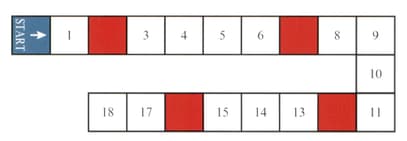A coin is biased such that the probability that three tosses all result in heads is . Find the probability of obtaining no heads with three tosses of the coin.

Important Questions on Probability
In a group of five men and four women, there are three pairs of male and female business partners and three teachers, where no teacher is in a business partnership. One man and one woman are selected at random. Find the probability that they are:
both teachers
In a group of five men and four women, there are three pairs of male and female business partners and three teachers, where no teacher is in a business partnership. One man and one woman are selected at random. Find the probability that they are:
in a business partnership with each other
In a group of five men and four women, there are three pairs of male and female business partners and three teachers, where no teacher is in a business partnership. One man and one woman are selected at random. Find the probability that they are:
each in a business partnership but not with each other.
A biased die in the shape of a pyramid has five faces marked and . The possible scores are and and , where is a constant.
Find, in terms of , the probability of scoring .
A biased die in the shape of a pyramid has five faces marked and . The possible scores are and and , where is a constant.
Find, in terms of , the probability of scoring less than .
A biased die in the shape of a pyramid has five faces marked and . The possible scores are and and , where is a constant.
The die is rolled three times and the scores are added together. Evaluate and find the probability that the sum of the three scores is less than .
A game board is shown in the diagram.
Players take turns to roll an ordinary fair die, then move their counters forward from 'start' a number of squares equal to the number rolled with the die. If a player's counter ends its move on a coloured square, then it is moved back to the start.

Find the probability that a player's counter is on 'start' after rolling the die once.
A game board is shown in the diagram.
Players take turns to roll an ordinary fair die, then move their counters forward from 'start' a number of squares equal to the number rolled with the die. If a player's counter ends its move on a coloured square, then it is moved back to the start.

Find the probability that a player's counter is on 'start' after rolling the die twice.
